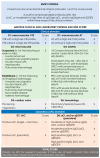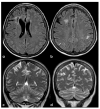Neurovascular Issues in Antiphospholipid Syndrome: Arterial Vasculopathy from Small to Large Vessels in a Neuroradiological Perspective
- PMID: 38999233
- PMCID: PMC11242764
- DOI: 10.3390/jcm13133667
Neurovascular Issues in Antiphospholipid Syndrome: Arterial Vasculopathy from Small to Large Vessels in a Neuroradiological Perspective
Abstract
Antiphospholipid syndrome (APS) is an autoimmune prothrombotic condition characterized by venous thromboembolism, arterial thrombosis, and pregnancy morbidity. Among neurological manifestations, arterial thrombosis is only one of the possible associated clinical and neuroradiological features. The aim of this review is to address from a neurovascular point of view the multifaceted range of the arterial side of APS. A modern neurovascular approach was proposed, dividing the CNS involvement on the basis of the size of affected arteries, from large to small arteries, and corresponding clinical and neuroradiological issues. Both large-vessel and small-vessel involvement in APS were detailed, highlighting the limitations of the available literature in the attempt to derive some pathomechanisms. APS is a complex disease, and its neurological involvement appears multifaceted and not yet fully characterized, within and outside the diagnostic criteria. The involvement of intracranial large and small vessels appears poorly characterized, and the overlapping with the previously proposed inflammatory manifestations is consistent.
Keywords: APS; MRI; SVD; antiphospholipid syndrome; intracranial occlusion; large vessels; moyamoya; neuroradiology; proliferative vasculopathy; vasculitis.
Conflict of interest statement
The authors declare no conflicts of interest.
Figures








References
-
- Corban M.T., Duarte-Garcia A., McBane R.D., Matteson E.L., Lerman L.O., Lerman A. Antiphospholipid Syndrome: Role of Vascular Endothelial Cells and Implications for Risk Stratification and Targeted Therapeutics. J. Am. Coll. Cardiol. 2017;69:2317–2330. doi: 10.1016/j.jacc.2017.02.058. - DOI - PubMed
Publication types
LinkOut - more resources
Full Text Sources
Miscellaneous

